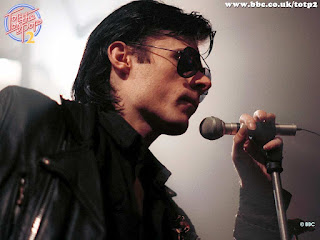Right, a number of you are now descending on my ghostmansion, waving pitchforks and chanting in an eldritch tongue iah-ngahn falt-rannra, which roughly translates as "You lying bastard" for those who do not speak Eldritch.
 |
| Eldritch |
But allow me to retort, before I am forced to resort (to the shotgun and hounds). I love the past in the same way I love the future; they are both pleasant places to take a short holiday in. The seaside, but with trans-temporal issues. Some people choose to live there, however, and it's rarely a healthy thing. Things rust by the seaside.
Some of those dwellers in the sandy coves of time (I feel contractually obliged to make a comment about Daily Telegraph readers about now) are prone to ranting that popular culture is losing its edge. The ghastly watchphrase of the late 2000s was dumbing down.
To my intense irritation, I may have found an example of just that; evidence that maybe some TV was a little more sophisticated back in the day.
 |
| I'm tempted to get one of these paintings for over the mantle, just to see if I can goad people into complimenting it |
Children of the Stones ran for seven weeks in the late 1970s. It's well written, aimed at kids and families and utterly compelling. You can find out the plot on a hundred sites I expect; suffice to say, it's a 'strangers in the village' scenario, with overtones of conformity, ancient forces, mind control and the ultimately illusory nature of reality. Like I said, kids' TV.
But Children of the Stones is so much more. It would be misleading to say that they don't make them like this anymore; they never made them like this, except, perhaps, The Owl Service. Sample dialogue, between the science-aristo villain Hendrick and his butler:
Butler: There is much to be said, I think for a celibate lifestyle.
Hendrick: And yet I have my children (indicating the village), the best of both worlds.
I really can't see anything like this going at half four nowadays. Not only does it rely on understanding the subtleties of the above relationship, we have to deal with heavy real-science (astronomy and the nature of the ammonia molecule are important to the plot) and the power of archetypes. Like so many other texts, it deals with the conflict of good and evil; however, here, evil is equated with repressed sexuality and rejection of creativity, whilst good is explicitly presented as social disobedience, rejection of tradition and embracing outsider status. And when we see the results of evil, there's no hedging around the issue; death comes for likeable characters, struck down, their blood visible, their pain and fear obvious. Worse than death for others who we've come to care about, their individuality burned away into a permanent brainless smile.
Since the age of five I have had a slight phobia about the countryside. Draw your own conclusions.
Green Knowe
ReplyDeleteOh yeah. Green Noah, demon tree. And that statue of St Christopher that comes to life and manages to be scarier than the bloody monsters...
ReplyDelete